There are more than 200 million active websites around the world now. The “online” world is more competitive than it has ever been. So if you’re going to create web or software products that perform, scale, and add value, you need to select a tech stack for web development that helps you do just that.
From the best frontend frameworks and server-side languages to modern databases, applications, and infrastructure, and development boardrooms – the choices they make directly impact how fast you can develop solutions, the quality and usability of the apps you build, and how amenable they are to long-term maintenance.
In this blog, we delve into the ultimate tech stacks for web development for 2025, the stack options that will empower developers, startups, and enterprises to bring intelligent products to market and drive industry innovation.
What Is meant by Tech Stack for Web Development?
A web development stack or tech stack is a collection of software that enables a web server or web server application to run websites. At the heart of it, a web stack usually consists of four key components: an OS, a programming language, a database, and a web server.
These are stacked, as each technology depends on the technology beneath to have a complete dev space. They work together to take care of tasks like processing user requests, storing data, and serving dynamic content in the browser.
Picking the best web stack is essential when it comes to web development or even for web app development. The wrong match can result in performance limitations, high costs of development, and a lack of scalability; the right combination means efficiency, flexibility, and the possibility for long-term success. A stack can be used in many projects, so it makes sense to choose the right setup from the start.
Components Of A Web Development Stack
Behind every software— be it a website, a web app,a mobile app, or an enterprise-grade system — is a group of technologies that work in synchrony but under the hood. They are what you’d call software development technology stacks and are usually classified by the layers they handle – frontend, backend, or both (full stack).
Let’s dissect the three primary varieties of tech stacks for web development that are used common today with development:
A.Frontend Tech Stack (Client-Side)
The frontend is the side of the application that users interact with, the interface, the stuff they see on their screens. The frontend stack is all about creating an easy, responsive, and accessible interface.
Some common technologies are used in the frontend development:
- HTML – to define the structure and order of page 1 and page 2.
- CSS – To style and make a visual appeal.
- JavaScript – for interaction and dynamic content
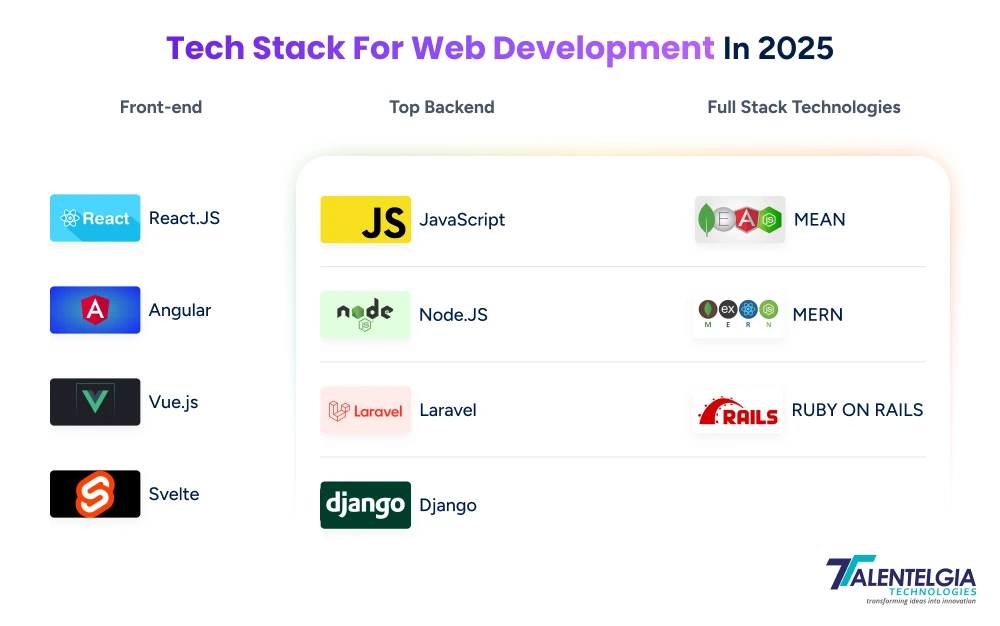
Modern frontend frameworks and libraries like the following have been picked up over the recent years:
- React.js
- Vue.js
- Angular
These utilities are used to optimize and simplify development, reduce overhead, and componentize the UI to simplify the development and maintenance of the larger applications.
B.Backend Tech Stack (Server-Side)
Backend is the brain of the software – the logic, the data processing, and what runs on the server side of things of a software. It deals with everything that the user doesn’t see, such as authentication, database queries, API calls, and business rules.
Some popular backend programming languages and frameworks are:
- Node. js
- Python (Django or Flask)
- PHP (Laravel)
- Ruby on Rails
- Java (Spring Boot)
Databases are also components of the backend stack, like:
- MySQL
- PostgreSQL
- MongoDB
- Firebase
C.Full-Stack Tech Stack
A full-stack tech stack comprises a front-end as well as a back-end component, and developers could utilize one set of tools to build an app in its entirety. This makes the communication between the layers easier and might save some time, and makes it easier to actually work with the code.
A few widely used full-stack pairings are:
- MERN Stack – MongoDB, Express. JS, React. JS, Node. js
- MEAN Stack – MongoDB, Express. JS, Angular, Node. js
- LAMP Stack: Linux, Apache, MySQL, and PHP
Startups and agile teams that must get quick, cost-efficient products to market particularly favor full-stack development.
Also Read:- LAMP Stack vs MEAN Stack
TECH STACK FOR WEB DEVELOPMENT
Selecting the suitable front-end technology is the key in making responsive, scalable and interactive web applications. As businesses and users demand more complex interfaces, developers today have a variety of feature-rich front-end frameworks available, each with its own strengths, and resources around it – and its learning curve.
Below are the most adopted front-end tech stacks for web development up to 2025 that still influence the world of web development today:
A.Frontend Technologies
- React.JS
If you are involved with developing responsive and reactive web applications, this React. js still reigns in the frontend development industry. Brought to you by Meta, the company behind Facebook, React tools and technologies allow developers to easily build fast, interactive user interfaces for everything from a lightweight single-page app to a powerful enterprise-scale website.
Why React Stands Out in 2025 ?
- Performance
Performance React is a virtual DOM (Document Object Model) that accelerates rendering. This enables rapid, efficient updates and, in turn, responsive pages with adequate user experience. React is one of the fastest front-end libraries you can utilize, because it’s got a smart diffing algorithm that cuts out most of the rerendering.
- Scalability
React helps you create scalable applications due to its component-based architecture. Developers can make reusable components, which can increase maintainability and help large teams to work together with fewer conflicts.
- Community & Ecosystem
React is backed by a huge community of developers in the world and an increasing ecosystem. If you consider UI libraries like Material UI, Chakra UI to state management tools such as Redux and Zustand then the React ecosystem has everything that’s necessary to build production-ready applications. And thanks to heavy community involvement, developers have a wealth of tutorials, forums, and open-source tools.
- Learning Curve
React is pretty easy to learn, especially for people who know JavaScript. But becoming proficient with more advanced concepts like Hooks and Context API and patterns for managing state, these demand a better understanding of JavaScript and the framework React itself.
- Angular
Angular is a feature-rich open-source frontend framework created and maintained by Google. In contrast to other lightweight libraries, Angular is a comprehensive solution that provides everything needed to develop a complex, enterprise-grade web application: a library of UI components, an encapsulation of CSS, and an organization of the application code into modules.
Why Angular Stands Out In 2025?
- Performance
Angular improves the application’s performance by compiling the app with Ahead-of-Time (AOT) compilation at build time, rather than at runtime. This minimizes load times, increases performance, and smoothens user experience, especially on large apps.
- Scalability
Angular is built for scalable development with a modular architecture and its powerful tools for managing app complexity with the Dependency Injection system. This is a framework that becomes a go-to option for those with large code bases, multi-team workflows, or long-form projects in the enterprise.
- Community & Ecosystem
Angular’s ecosystem is mature, with strong tools such as:
- Angular CLI (for fast and easy project setup)
- Angular Material – for out-of-the-box UI components
- RxJS – to deal with reactive programming design patterns
With its corporate backing from Google, Angular receives regular updates and long-term support, not to mention well-established community efforts and third-party support.
Also Read : Angular vs React vs Vue: Core Differences
- Vue.js
Vue.js found its unique niche by merging Angular’s good points and React’s flexibility together. Introduced in 2014, Vue is designed to make it easier to create your UI—without the learning curve sometimes associated with more robust frameworks.
Vue’s minimalist approach, simplicity, and ease of integration are what make it stand out. Including fabulous features such as the ultra-modern reactive two-way data binding, built-in component-based architecture, and a refreshing syntax, it’s all coming without the dreaded boilerplates and additional third-party libraries as dependencies.
As of today, Vue is being used by over 1.7 million websites. JS, and has a strong base among the world’s top JavaScript libraries. Its popularity is growing and for all the right reasons: A dedicated developer community, it also has over 190,000 stars on GitHub – this too signals trust and adoption.
Performance
Vue has a remarkable performance due to its reactive core and optimized rendering system. It has virtual DOM as React and has the best performance in my own experience of a component level fine grained reactivity which makes it very fast, even with complex interfaces. You get smooth, snappy UIs without a lot of processing overhead.
Scalability
With its component-based approach, you can develop small to large apps with an ease. Developers can create reusable and encapsulated components that increase productivity and are easy to develop and easy to test. Whether you’re building a simple widget or an entire app, Vue will grow with your needs at its own pace.
Community & Ecosystem
Thanks to its large and actively growing community of developers, Vue has a rich ecosystem of libraries and tools. Vue CLI, Vue Router, Pinia (for state management), and Vuex help you develop faster and make your work more organized. The popularity in Asia, especially in China, has also contributed to a lot of enterprise adoption, so it’s also challenging the global frontend framework.
Learning Curve
Vue is well regarded for having a “low learning curve”. For those that already know HTML, CSS, and JavaScript, the learning curve is extremely minimal. The logical structure of the framework, as well as its clean, concise syntax and its perks such as excellent documentation, makes it perfect for beginners and highly effective for experienced devs. Although more complex subjects such as SSR (Server-Side Rendering) and Composition API may need more in-depth education.
- Svelte
Svelte is an atypical JavaScript framework. In contrast to React or Vue that perform most of their work in the browser, Svelte pushes that work to build time. The framework inspects your code during the build, compiles it to highly optimized javascript, eschewing the need for a virtual dom and running faster at runtime. Svelte is gaining some solid traction among devs looking for a lightweight, modern way of building on the frontend in 2025.
- Scalability
Svelte is good for small or mid-sized apps. It can scale but its ecosystem is still quite young and it can be harder to do large enterprise projects with it than with React or Angular. That said, thanks to its modular approach, Svelte does make it easy to neatly organise your components and handle state in the most efficient way.
- Performance
Svelte turns components into very powerful JavaScript. That’s what allows DOM updates to be performed surgically, and it’s what makes the framework so fast. Since there’s no virtual DOM to maintain, Svelte apps feel snappy and need less overhead, particularly on lower-powered devices or over mobile networks.
- Community & Ecosystem
Svelte is still working to build its own community, but it’s gaining momentum. On developer surveys such as Stack Overflow and State of JS, it is consistently ranked as one of most loved frameworks. The ecosystem is maturing with more support for routing, state management, and integrations, primarily from SvelteKit.
- Learning Curve
It’s also got an extremely gentle learning curve, especially if you’re familiar with HTML, CSS and JS. You don’t have to learn about really complex things like JSX or dependency injection. But because Svelte introduces its syntax, as well as its own way of reasoning about compilers, developers may need a little time getting used to it, especially when starting to use it with older codebases or third-party libraries.
When to Use Svelte?
Svelte is great for projects where speed, efficiency, and short development cycles count. But if you’re creating a light-weight single-page app (SPA), a progressive web app (PWA), or just dynamic UI components for your site with no client-side framework at all, the terseness of Svelte’s code, and that reactivity model, can be a huge boon.
Quick Read: Svelte Vs Vue
B.Top Backend Technolgies For Web Development In 2025
The backend of a web application consists of the logic, databases, APIs, and server components of the application. When scalability, performance, and security are key attributes in 2025, the technology you select for your backend can make or break your web project. Here are some of the most popular and powerful backend technologies available to developers now.
- JavaScript
JavaScript has been a popular language in frontend development for the last few decades and has been proving itself to be just as good on the backend in recent years. Being a full-stack language, it is one of the favorite languages to go for modern web development. Whether creating light weight API-driven applications or large scale cloud based enterprise systems JavaScript can perform with excellence at every level.
In the most recent Stack Overflow Developer Survey, 70.2% of web developers cited JavaScript as their go-to language -a clear indication of its status as a developer favorite globally.
Why JavaScript is the Best Language for Backend Development
- Client-Side Efficiency: Javascript eliminates server load by conducting several operations on the client side, thus accelerating interactions and enhancing responsiveness.
- Asynchronous operations: Due to non blocking I/O operations and promises, Javascript (esp with node. js) can perform many operations at the same time and dramatically improve both code and application performance.
- Dynamic Typing: With flexible data types that aren’t rigidly defined, developers can build faster, reduce memory usage, and easily adhere to clean coding practices.
- Huge Ecosystem: The Node.js environment brings access to thousands of open-source packages via npm, enabling faster development and integration.
Businesses That Use JavaScript as a Backend Technology
Tech and eCommerce giants in the world use JavaScript to fuel their backend systems:
- Netflix – For coordinate manner streaming and cross-device support.
- PayPal – for fast release cycles and a front-end-backend stack.
- Uber for real time processing of data and tracking rides.
- eBay – for implementing server-side high-performance functionalities.
- Microsoft – for full-stack JavaScript development using modern web apps.
- Node.JS
Node. js revolutionized backend development by finally allowing the server side to operate in JavaScript. Being an open-source, cross-platform JavaScript run-time environment, Node. js allows developers to develop fast, scalable, and real-time applications on both the server and client sides, in other words, all written in JavaScript.
Powered by Google’s ultrafast V8 engine, Node. js to write back-end logic, server side scripts, REST APIs and even real-time applications very easily.
- High Performance: Node. js is really good at doing asynchronous, non-blocking I/O, which is very suitable for high-performance apps. Streaming, real-time chatting, API-heavy, Node provides speed and scale.
- Scalability: Node. js can be scaled vertically and horizontally. Scale one server up (vertical) or distribute between many servers (horizontal) with as little friction as possible-ideal for work in progress applications.
- Large Community & Ecosystem: Node. js has a huge developer community, and an increasing number of npm packages. It’s been powered by innovation and continuous updates — supported by tech giants such as Google, Amazon and Meta.
- Smart Caching: Node. js caches each module,reducing the server burden and improving the response speed. That gives better performance for people coming back into the app and it helps the app in general be more efficient.
Companies That Trust Node.js
Many global businesses rely on Node.js to deliver real-time experiences and scale backend operations:
- Netflix – for handling streaming data efficiently.
- LinkedIn – to speed up mobile backend communication.
- Trello – for real-time collaborative workflows.
- Walmart – to handle massive eCommerce traffic.
- Uber – to support real-time data handling across its platform.
- Laravel
Laravel is a robust, open-source backend framework that was built to use the model-view-controller structure. It speeds up, and makes web development in PHP by providing developers with a clean, elegant syntax for instant development, minimising the intricacies of databases, forms and more.
Due to its integrated capabilities and community-based ecosystem, Laravel has garnered a reputation as one of the most popular PHP frameworks amongst developers and businesses.
Top Features:
- Pre-made Packages & Integrations: It should be noted that Laravel features several out-of-the-box packages, such as OAuth integration with Google, Facebook, LinkedIn, and GitHub, meaning you can get your app up and running with very little configuration.
- Extremely Secure: Laravel ensures its maximum security with its built-in high class security services. It leverages Bcrypt hashing to secure passwords and sensitive user information, and has built-in support for mitigating CSRF, XSS, and SQL injection attacks.
- Robust Exception Handling: Laravel provides efficient error and exception handling with a system that is easy to debug and will keep your users happy. Custom error messages and auto reporting contribute to developer efficiency.
Companies That Trust Laravel
Laravel is trusted by modern startups and mid-size enterprises for building robust, secure, and maintainable web apps:
- 9GAG – for scalable content-heavy web applications.
- Crowdcube – for secure financial and crowdfunding platforms.
- Razorpay – to manage secure transaction systems.
- Invoice Ninja – for multi-user SaaS platforms with strong admin control.
- Django
Django is a high-level open-source back-end web framework and it is written in python, it aims to follow the fast development, clean, and pragmatic design, and secure web applications building. Django imposes a standard structure on your projects which makes it easier to handle applications integrated in big projects as the one we’re going to build.
- Vibrant Developer Community: One of the most vibrant open-source communities, Django developers all around the world provide constant support, plugins, and open source contributors. Whether you’re troubleshooting or seeking new plugins, the community never lets you down.
- Excellent Documentation: Django has the best documentation in all of web development. It’s logically organized, well-maintained, easy for novice and pro alike to use etc, etc, all of which will save you time and steepen your learning curve.
- Out-of-the-box Security: Django provides built-in security against major web security issues such as SQL injection, cross-site scripting, cross-site request forgery, and clickjacking. It also comes with a powerful user authentication system, perfect for apps where securing user data is a priority.
Companies That Use Django
Django powers some of the web’s most-used sites for its speed language: Python base is known for its quick data-driven, results focused language.
- Instagram – scales to millions of users and realtime data feeds.
- Spotify – combines Django with machine learning capabilities.
- Disqus – handling massive amounts of comments with Django’s scalability.
- Mozilla – we use Django to power our back end applications securely.
Also Read: Top Ten Backend Frameworks
C.Top Full-Stack Technologies For Web Development
In 2025, while hiring full-stack development companies, full-stack technologies will become more than just tech stacks, they’re holistic ecosystems that help developers create, test, and scale applications with unprecedented speed. Whether you’re creating a startup MVP, working on existing enterprise software, or scaling a real-time platform, making the right decision in a full-stack combo is essential. Here’s the top full stack technologies that developers are using to revolutionize front and back-end web development.
- MEAN Stack
The MEAN stack is a scalable full-stack JavaScript solution that is used for building fast,robust and maintainable production web applications. It combines four open-source projects, MongoDB, Express. js, Angular, and Node. js that gracefully handle both client- and server-side development.
This widely used tech stack is a good choice for companies that wish to build modern, cloud-based apps that run in a single and consistent JavaScript environment across the board.
Here is what MEAN stands for:
- MongoDB
A NoSQL data store, very flexible, data is stored as JSON-like documents. It’s an excellent tool for unstructured data and scaling with cloud-based applications.
- Express.js
Web application framework for node, built with power and simplicity in mind. js. It takes care of routing, middleware management and data transfer between the browser and the server side.
- Angular
A Google built frontend framework. Angular helps developers to design single-page applications(SPA) with responsive UI and two-way data binding.
- Node.js
A server side runtime, utilizing the V8 engine by Google. Node. js With its non-blocking and event-driven architecture, node.
Key Advantages of the MEAN Stack
- Full JavaScript Stack: JavaScript is used across all layers, reducing the need for switching between different languages.
- Scalability: MEAN is suitable for both small applications and enterprise-grade platforms.
- Speed & Performance: With Node.js handling backend operations and MongoDB’s flexible schema, applications run fast and scale efficiently.
- Open Source & Community-Driven: Each component of the MEAN stack has strong community support and a vast number of plugins and libraries.
Choose the MEAN stack if:
- You are developing a cloud-native web app (also called a single-page application).
- Your team is familiar with JavaScript.
- You are looking for a fast development cycle with code you can reuse.
- You are going to horizontally scale the Application in the future.
- MERN Stack
MERN is a leading technology stack for building robust, full-stack web applications using JavaScript. It is built with four robust open-source tools—MongoDB, Express. js, React. js, and Node. js systems combine to bring end-to-end development using a single programming language, JavaScript.
Whether you are designing a slick single-page app or a major enterprise system with real-time capabilities, the MERN stack allows you to develop in a unified environment, with many available libraries.
- MongoDB
A flexible, document-based NoSQL data store that has JSON documents. It’s also super easy to scale and a natural fit for cloud applications.
- Express.js
A small Node web framework. js for quick and secure APIs. It handles routing, middleware, and HTTP requests with ease.
- React.js
Frontend JavaScript library created and maintained by Meta (formerly Facebook). With React, developers can create interactive UIs using a few reusable components updated in real time.
- Node.js
A JavaScript runtime environment that executes server-side code. Node.js powers the backend, enabling asynchronous, non-blocking I/O operations
Why Choose the MERN Stack?
- Shared Coding Language: All your developers will work with everyone on the stack to create better developed with less code.
- Component-Based UI: React’s component model enables building UIs that are composable and reusable across projects and theme changes.
- Powerful Ecosystem: npm gives you access to a huge amount of JavaScript libraries and tools.
- JSON All the Way: Since MongoDB, Express, React, and Node all use JSON, data flows seamlessly between layers without conversion hassles.
- Ruby-On-Rails
Ruby on Rails (RoR) is a powerful open-source web application framework built on the Ruby programming language, used for server-side development. The toolkit has been very popular with developers who want to write clean code and speed up their development process ever since it was released in 2005.
RoR follows two core principles:
- Don’t Repeat Yourself (DRY) – Avoid code duplication and enhance reusability.
- Convention Over Configuration (CoC) – Focus on productivity by following default patterns instead of writing endless configurations.
Why Choose Ruby on Rails?
- Speed & Productivity: The framework comes with a set of tools and conventions that allow developers to craft both MVPs and full-featured applications easily.
- Concise Syntax: Ruby’s clean syntax is easily read and not prone to bugs.
- vAst Library ecosystem: RoR has a vast number of libraries (gems) that allows developers to add functionality without re-inventing the wheel.
- Scalability & Security: RoR incorporates built-in protection against major avenues of attacks such as SQL injections and CSRF.
When to Use Ruby on Rails
- Rapid MVP development
- E-commerce platforms
- Content management systems (CMS)
- Social media and collaboration tools
- SaaS applications
Conclusion
The Tech Stack is very important as it helps create effective, scalable and future-ready web applications. Whether you choose the flexibility of MERN, the strong structure of MEAN, or the elegance of JAMstack, every technology stack fits specific project requirements as well as developer approaches. The web development landscape is evolving, and being up to date with modern web stacks not only makes your sites or apps performant and user friendly – it also allows you to maintain it for a long time. The trick lies in matching your tech selections with your project aims, team proficiency, and business expansion plans.


 Healthcare App Development Services
Healthcare App Development Services
 Real Estate Web Development Services
Real Estate Web Development Services
 E-Commerce App Development Services
E-Commerce App Development Services E-Commerce Web Development Services
E-Commerce Web Development Services Blockchain E-commerce Development Company
Blockchain E-commerce Development Company
 Fintech App Development Services
Fintech App Development Services Fintech Web Development
Fintech Web Development Blockchain Fintech Development Company
Blockchain Fintech Development Company
 E-Learning App Development Services
E-Learning App Development Services
 Restaurant App Development Company
Restaurant App Development Company
 Mobile Game Development Company
Mobile Game Development Company
 Travel App Development Company
Travel App Development Company
 Automotive Web Design
Automotive Web Design
 AI Traffic Management System
AI Traffic Management System
 AI Inventory Management Software
AI Inventory Management Software
 AI Software Development
AI Software Development  AI Development Company
AI Development Company  AI App Development Services
AI App Development Services  ChatGPT integration services
ChatGPT integration services  AI Integration Services
AI Integration Services  Generative AI Development Services
Generative AI Development Services  Natural Language Processing Company
Natural Language Processing Company Machine Learning Development
Machine Learning Development  Machine learning consulting services
Machine learning consulting services  Blockchain Development
Blockchain Development  Blockchain Software Development
Blockchain Software Development  Smart Contract Development Company
Smart Contract Development Company  NFT Marketplace Development Services
NFT Marketplace Development Services  Asset Tokenization Company
Asset Tokenization Company DeFi Wallet Development Company
DeFi Wallet Development Company Mobile App Development
Mobile App Development  IOS App Development
IOS App Development  Android App Development
Android App Development  Cross-Platform App Development
Cross-Platform App Development  Augmented Reality (AR) App Development
Augmented Reality (AR) App Development  Virtual Reality (VR) App Development
Virtual Reality (VR) App Development  Web App Development
Web App Development  SaaS App Development
SaaS App Development Flutter
Flutter  React Native
React Native  Swift (IOS)
Swift (IOS)  Kotlin (Android)
Kotlin (Android)  Mean Stack Development
Mean Stack Development  AngularJS Development
AngularJS Development  MongoDB Development
MongoDB Development  Nodejs Development
Nodejs Development  Database Development
Database Development Ruby on Rails Development
Ruby on Rails Development Expressjs Development
Expressjs Development  Full Stack Development
Full Stack Development  Web Development Services
Web Development Services  Laravel Development
Laravel Development  LAMP Development
LAMP Development  Custom PHP Development
Custom PHP Development  .Net Development
.Net Development  User Experience Design Services
User Experience Design Services  User Interface Design Services
User Interface Design Services  Automated Testing
Automated Testing  Manual Testing
Manual Testing  Digital Marketing Services
Digital Marketing Services 
 Ride-Sharing And Taxi Services
Ride-Sharing And Taxi Services Food Delivery Services
Food Delivery Services Grocery Delivery Services
Grocery Delivery Services Transportation And Logistics
Transportation And Logistics Car Wash App
Car Wash App Home Services App
Home Services App ERP Development Services
ERP Development Services CMS Development Services
CMS Development Services LMS Development
LMS Development CRM Development
CRM Development DevOps Development Services
DevOps Development Services AI Business Solutions
AI Business Solutions AI Cloud Solutions
AI Cloud Solutions AI Chatbot Development
AI Chatbot Development API Development
API Development Blockchain Product Development
Blockchain Product Development Cryptocurrency Wallet Development
Cryptocurrency Wallet Development About Talentelgia
About Talentelgia  Our Team
Our Team  Our Culture
Our Culture 
 Healthcare App Development Services
Healthcare App Development Services Real Estate Web Development Services
Real Estate Web Development Services E-Commerce App Development Services
E-Commerce App Development Services E-Commerce Web Development Services
E-Commerce Web Development Services Blockchain E-commerce
Development Company
Blockchain E-commerce
Development Company Fintech App Development Services
Fintech App Development Services Finance Web Development
Finance Web Development Blockchain Fintech
Development Company
Blockchain Fintech
Development Company E-Learning App Development Services
E-Learning App Development Services Restaurant App Development Company
Restaurant App Development Company Mobile Game Development Company
Mobile Game Development Company Travel App Development Company
Travel App Development Company Automotive Web Design
Automotive Web Design AI Traffic Management System
AI Traffic Management System AI Inventory Management Software
AI Inventory Management Software AI Software Development
AI Software Development AI Development Company
AI Development Company ChatGPT integration services
ChatGPT integration services AI Integration Services
AI Integration Services Machine Learning Development
Machine Learning Development Machine learning consulting services
Machine learning consulting services Blockchain Development
Blockchain Development Blockchain Software Development
Blockchain Software Development Smart contract development company
Smart contract development company NFT marketplace development services
NFT marketplace development services IOS App Development
IOS App Development Android App Development
Android App Development Cross-Platform App Development
Cross-Platform App Development Augmented Reality (AR) App
Development
Augmented Reality (AR) App
Development Virtual Reality (VR) App Development
Virtual Reality (VR) App Development Web App Development
Web App Development Flutter
Flutter React
Native
React
Native Swift
(IOS)
Swift
(IOS) Kotlin (Android)
Kotlin (Android) MEAN Stack Development
MEAN Stack Development AngularJS Development
AngularJS Development MongoDB Development
MongoDB Development Nodejs Development
Nodejs Development Database development services
Database development services Ruby on Rails Development services
Ruby on Rails Development services Expressjs Development
Expressjs Development Full Stack Development
Full Stack Development Web Development Services
Web Development Services Laravel Development
Laravel Development LAMP
Development
LAMP
Development Custom PHP Development
Custom PHP Development User Experience Design Services
User Experience Design Services User Interface Design Services
User Interface Design Services Automated Testing
Automated Testing Manual
Testing
Manual
Testing About Talentelgia
About Talentelgia Our Team
Our Team Our Culture
Our Culture
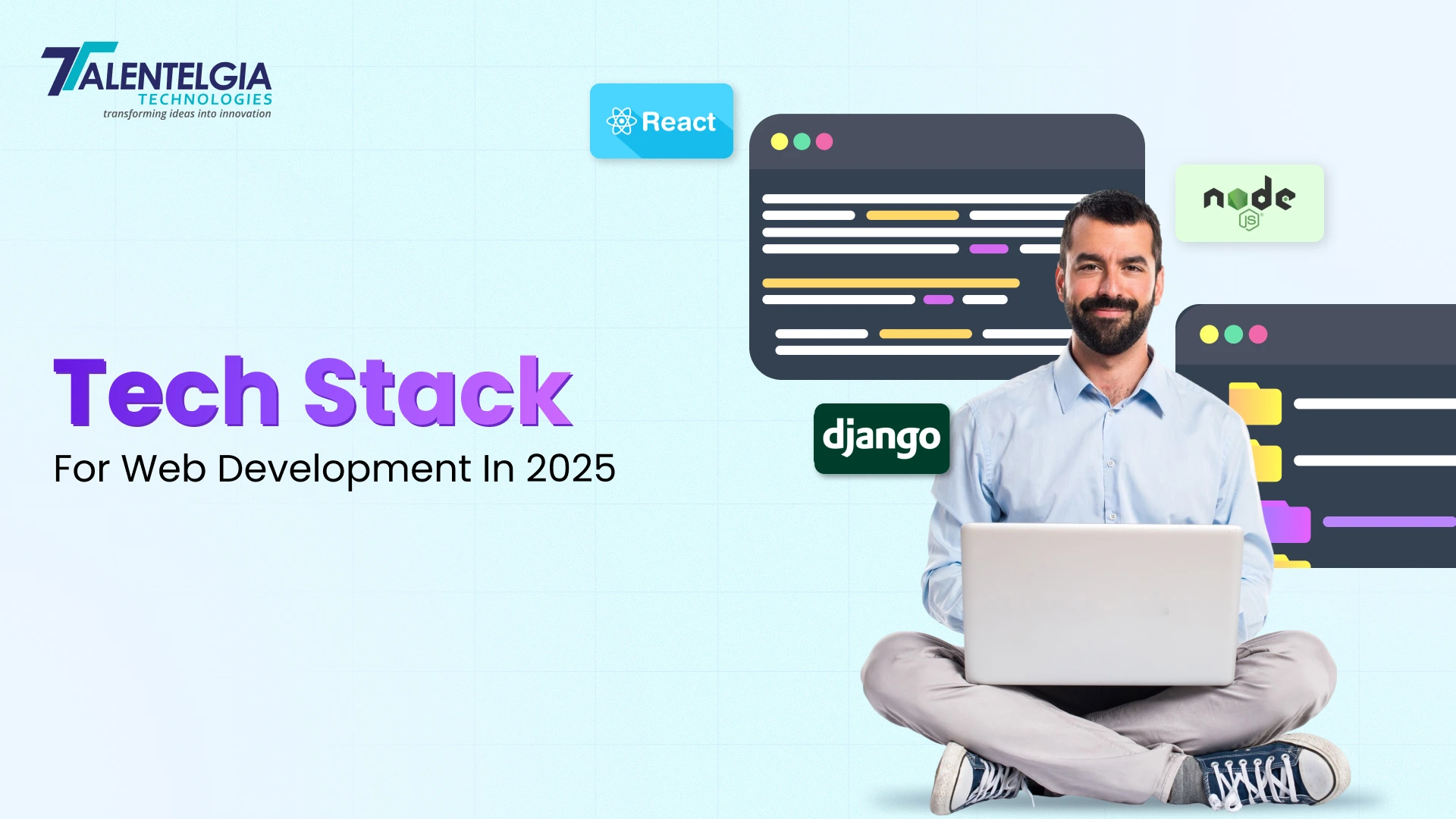



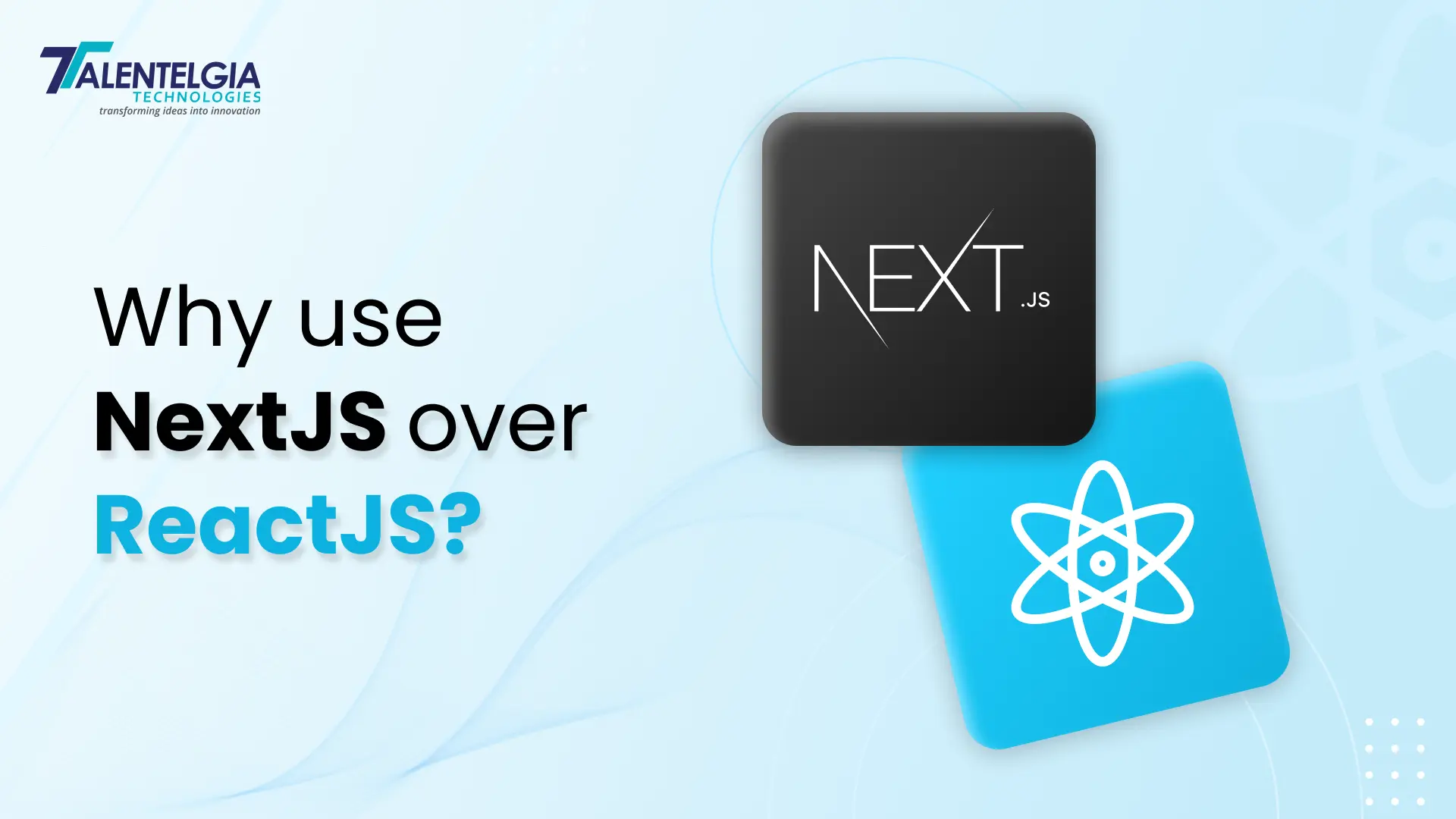
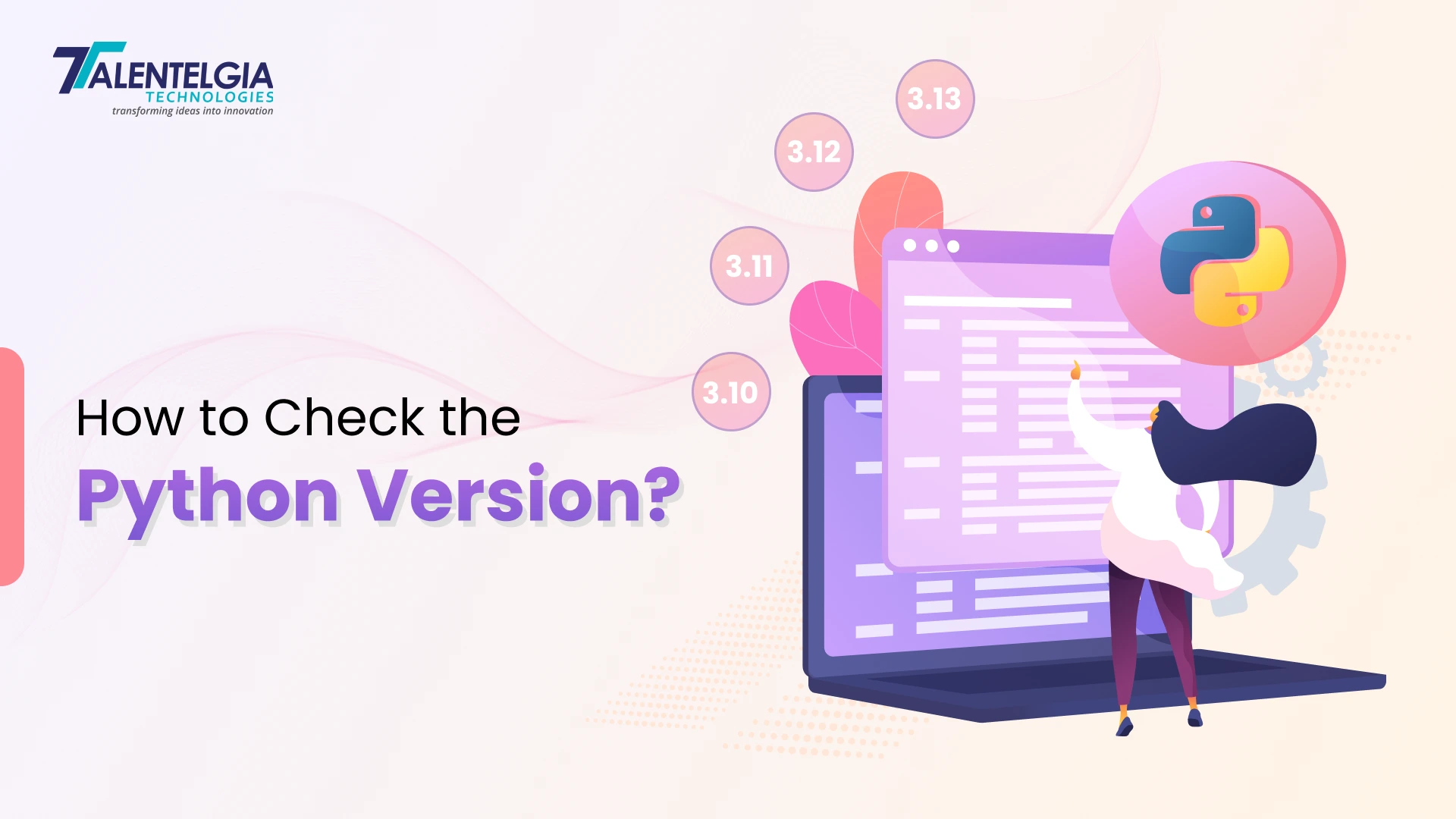










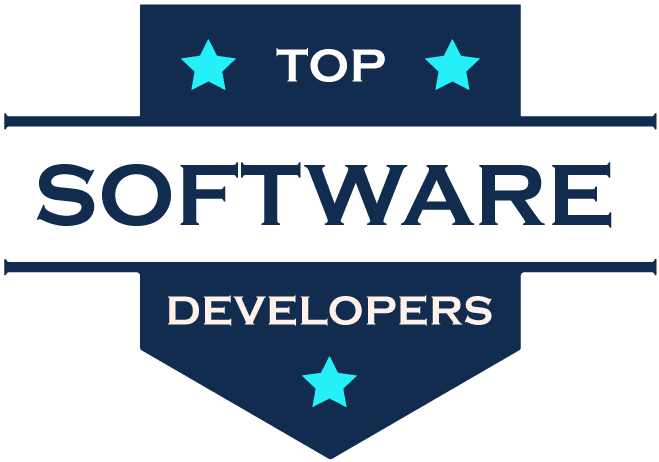
 Write us on:
Write us on:  Business queries:
Business queries:  HR:
HR: 




